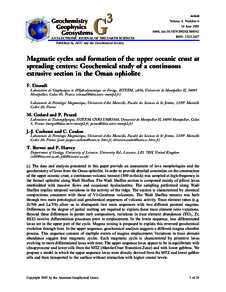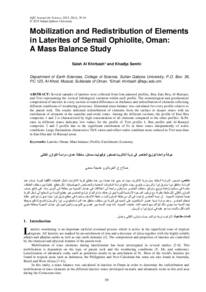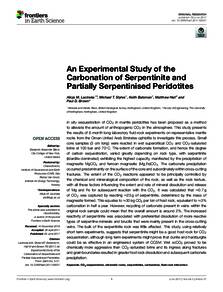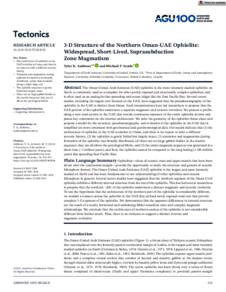Document
Magmatic cycles and formation of the upper oceanic crust at spreading centers : geochemical study of a continuous extrusive section in the Oman ophiolite.
Identifier
DOI: 10.1029/2002GC000362
Source
Geochemistry, Geophysics, Geosystems. v. 4, 6, 8608
Contributors
Godard, M., Author
Pezard, P., Author
Cocheme, J. J., Author
Coulon, C., Author
Brewer, T., Author
Harvey, P., Author
Country
United States.
City
Hoboken
Publisher
Blackwell Publishing Ltd.
Gregorian
2003-06-01
Language
English
Subject
English abstract
[1] The data and analysis presented in this paper provide an assessment of lava morphologies and the geochemistry of lavas from the Oman ophiolite. In order to provide detailed constraints on the construction of the upper oceanic crust, a continuous volcanic transect (300 m-thick) was sampled at high-frequency in the Semail ophiolite along Wadi Shaffan. The Wadi Shaffan section is composed mainly of pillow lavas interbedded with massive flows and occasional hyaloclastites. The sampling performed along Wadi Shaffan implies temporal variations in the activity of the ridge. The section is characterized by chemical compositions consistent with those of V1-Geotimes volcanism. The Wadi Shaffan transect was built through two main petrological and geochemical sequences of volcanic activity. Trace element ratios (e.g. Zr/Nb and La/Yb) allow us to distinguish two main sequences with two different parental magmas. Differences in the degree of partial melting are required to explain these trace element ratio variations. Beyond these differences in parent melt composition, variations in trace element abundances (TiO2, Zr, REE) involve differentiation processes prior to emplacement. In the lower sequence, less differentiated lavas are in the upper part of the cycle. Magma mixing is proposed to explain this reversed geochemical evolution through time. In the upper sequence, geochemical analysis suggests a different magma chamber process. This sequence consists of multiple events of magma emplacement. Variations in trace element abundance suggest four magmatic cycles. Each magmatic cycle is characterized by primitive lavas evolving to more differentiated lavas with time. The upper sequence lavas appear to be in equilibrium with clinopyroxene and lower sills from the MTZ (Mantle-Crust Transition Zone) and with lower gabbros. We propose a model in which the upper sequence lavas were directly derived from the MTZ and lower gabbro sills and then transported to the surface without interaction with higher crustal levels.
ISSN
1525-2027
Category
Journal articles




